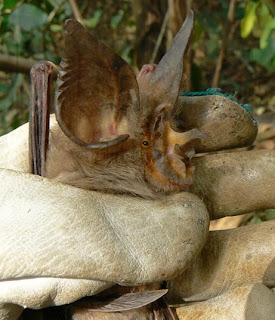
A Maclaud's horseshoe bat (being held in a glove) poses for the ladies...
For the first time, scientists photographed a Maclaud's horseshoe bat in the forests of Guinea in West Africa. These bats had not been seen in the wild in over 40 years. The featured photo was snapped by German biologist Natalie Webber, who found 16 horseshoe bats living in a remote cave complex. "Our rediscovery is good news insofar as the species is still there and as we have shown that the distribution range appears to be somewhat larger than previously known," said Jakob Fahr, a German ecologist who headed up the scientific team, as quoted in an article in National Geographic online. Their discovery is bad news insofar as THAT IS THE MOST HORRIFIC LOOKING BAT EVER SEEN! Scientists believe that the bat's gratuitous skin flaps somehow aid it in echolocation. There are approximately 70 known species of horseshoe bats, and the Maclaud's variety is among the most scarce and least studied.




